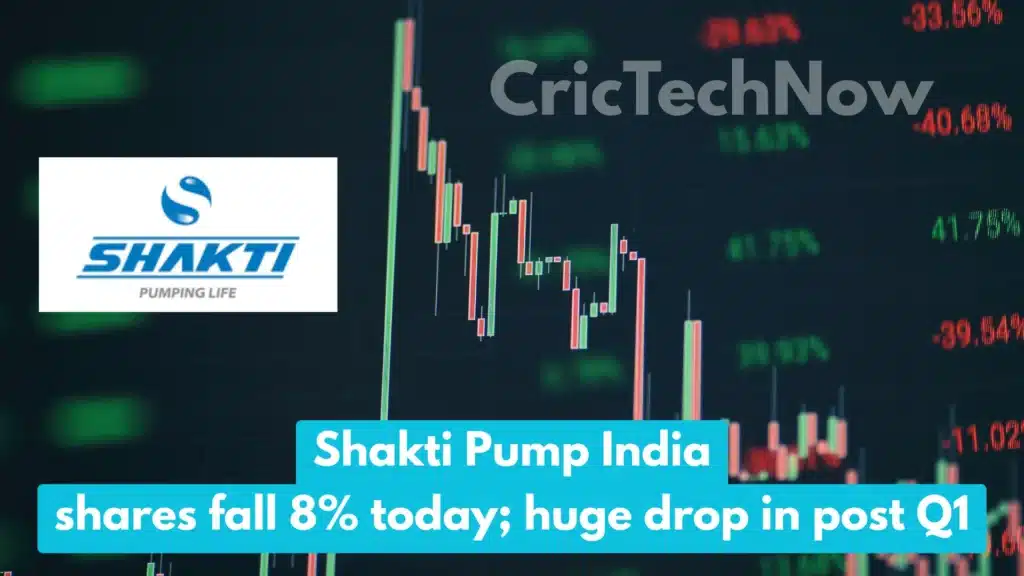Introduction
On August 4, 2025, Shakti Pumps (India) shares fell sharply—around 7.6% to 8%, hitting a recent low on the Bombay Stock Exchange (BSE) and National Stock Exchange (NSE). Despite reporting growth in sales and profit, investors reacted negatively. This story explains why the share price dropped so much, what the company reported, and what lies ahead.
What Triggered the Big Drop in Shakti Pumps?
Even though Shakti Pumps reported sales and profit growth in the quarter ending June 2025 (Q1 FY26), the stock sank due to investor worries over valuation and near‑term momentum.
According to Business Today, shares dropped 7.59% to around ₹825.65 on BSE, as the “tepid” quarterly performance did not meet high market expectations.
Most sources put the drop around 8%, with values close to ₹822–₹865 per share depending on timing and platform.
Q1 Results: What the Company Reported
Here’s a simple recap of key figures from Q1 FY26:
Revenue grew by about 9.7% YoY to ₹622–623 crore, up from ₹567–568 crore last year.
Net Profit (PAT) increased by around 4.5% YoY, reaching ₹96.8 crore versus ₹92.7 crore a year ago.
EBITDA rose about 5.7% YoY to ₹144 crore, but margins slipped — EBITDA margin dropped from ~23.9% to 23.1%, and PAT margin eased slightly to around 15.5%–15.6%.
In spite of growth, those margin declines and moderate profit rise may have failed to meet market hopes.
Reasons Behind Investor Concerns
Several factors may help explain the negative reaction:
- Valuation fears
Even after the good numbers, some investors felt the stock was overvalued. Shakti Pumps’ P/E ratio stood around 24–25x, while the company trades below its key moving averages and appears oversold on technical charts.
- Soft momentum
Though profit and revenue grew, the pace may not have matched what investors expected. Margins slipped slightly, and growth rates remained low single digits for PAT.
- Investment moves & strategy questions
The company invested in its EV arm and the solar cell project, raising some concern over capital allocation and near‑term returns.
Company Outlook & Future Plans
Despite the weak market reaction, Shakti Pumps continues to present a positive vision:
Strong order book: As of August 1, 2025, the firm had about ₹1,350 crore in confirmed orders, driven by government tenders under schemes like PM‑KUSUM across states including Maharashtra, Rajasthan, UP, Punjab, Haryana, Jharkhand, and others.
Clean energy focus: The company is expanding in the solar sector with its solar DCR cell and solar PV module manufacturing plant in Pithampur, Madhya Pradesh, with a capacity of 2.2 GW. It also invested ₹12 crore in its subsidiary, and raised around ₹292 crore through a QIP for funding the project.
Exports growth: Shakti Pumps has seen its export business grow at roughly 25% CAGR over four years, with projects in countries like Haiti, Uganda, Bangladesh, Nepal, and increasing demand in the Middle East, Africa, and the US.
Revenue targets: Management reaffirmed guidance for 25–30% revenue growth in FY26, aiming to sustain such growth over the next 3–4 years with its clean energy platform, disciplined operations, and strong order pipeline.
Read More: Trump Slams India Over Russian Imports
Short Term vs Long Term: What Should Investors Consider?
Here’s what investors might weigh:
Short term (1–3 months): The drop reflects short‑term concerns. If margins continue slipping or order inflows slow, pressure may persist. Technical charts show the stock trading below multiple moving averages and entering oversold zones.
Long term (1–3 years): Shakti Pumps has delivered massive returns—over 2,700% in the past five years, and roughly 550% to 960% over the past 2–3 years. Its long‑term growth in solar and exports makes it well positioned if execution holds.
Risk/reward balance: The valuation is relatively high (P/E ~25x), but if future growth and margin expansion materialize, upside exists. Conversely, if macro or tender cycles shift, downside is possible.
Conclusion
On August 4, 2025, shares of Shakti Pumps India fell nearly 8% after Q1 FY26 results failed to meet high investor expectations, despite 9.7% revenue growth and 4.5% profit growth. Margin dips, valuation concerns, and a cautious investor outlook weighed on the stock. Yet the company remains optimistic, pointing to a ₹1,350 crore order book, investments in solar and EV segments, strong export growth, and a target to grow revenue 25–30% in FY26. For long‑term investors who believe in execution and clean energy expansion, the near‑term drop may present an opportunity—but short‑term cautiousness is understandable given market pricing and performance signals.





